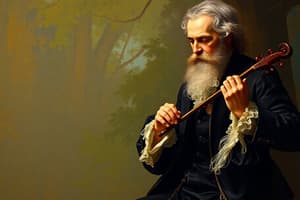Podcast
Questions and Answers
What is a characteristic of music during the Romantic Era?
What is a characteristic of music during the Romantic Era?
- Fulfilled an inner need rather than a commission (correct)
- Composed mainly for churches
- Focused solely on instrumental compositions
- Created only for the upper class
What led to the formation of many orchestras and opera groups during the Romantic Era?
What led to the formation of many orchestras and opera groups during the Romantic Era?
The rise of the urban middle class.
Which of the following describes the use of melodies in Romantic Era music?
Which of the following describes the use of melodies in Romantic Era music?
- Only short, repetitive melodies
- Flowing melodies accompanied by rich harmonies (correct)
- Melodies without harmony
- Strictly classical melodies
Lengthy symphonies and concertos became popular during the Romantic Era.
Lengthy symphonies and concertos became popular during the Romantic Era.
What does nationalism in Romantic music refer to?
What does nationalism in Romantic music refer to?
What forms of music became prominent during the Romantic Era?
What forms of music became prominent during the Romantic Era?
What was the focus of expressive aims and subjects in the Romantic Era?
What was the focus of expressive aims and subjects in the Romantic Era?
What was the role of timbre in Romantic Era music?
What was the role of timbre in Romantic Era music?
Program music is instrumental music associated with a story or idea.
Program music is instrumental music associated with a story or idea.
Romantic music is characterized by its greater __________ of tone color, dynamics, and pitch.
Romantic music is characterized by its greater __________ of tone color, dynamics, and pitch.
What did the Romantic Era emphasize in terms of harmony?
What did the Romantic Era emphasize in terms of harmony?
Flashcards are hidden until you start studying
Study Notes
Music in the Romantic Era
- Music reflects richness, variety, and importance, prioritizing inner expression over commissions from aristocrats or churches.
- Composers emerged from the middle class, catered to middle-class audiences, and often engaged in multiple roles, including conductor and music teacher.
- Urban middle-class growth led to the rise of orchestras, opera groups, and subscription concerts.
- Private music-making surged, particularly with the piano.
- Establishment of music conservatories in Europe and the U.S. marked a significant advancement in music education.
- Rise of solo recitals and larger concert halls expanded public engagement with music.
Characteristics of Romantic Era Music
- Retains classical era musical forms while introducing expressive, song-like melodies.
- Incorporation of flowing melodies with rich harmonies and frequent chromatic notes.
- Rhythm and tempo became more fluid with less strict adherence.
- Lengthy compositions, including symphonies, concertos, and operas, became prominent.
- Music exhibits a rich, warm, and passionate quality infused with drama and contrasts.
- Expanded tonal ranges, dynamic variability, and pitch complexity characterized the music.
- Harmonic vocabulary broadened with greater emphasis on colorful, unstable chords and tension.
Individuality of Style
- Stressed self-expression and unique styles, resulting in music that reflects composers' personalities.
Expressive Aims and Subjects
- Explored a wide range of emotions, including flamboyance, intimacy, and melancholy, often glorifying romantic love.
- Featured themes drawn from nature, folklore, and historical influences, including references to medieval tales and Shakespearean dramas.
Nationalism and Exoticism
- Music became a vehicle for national identity, incorporating folk elements and historical references from composers' homelands.
- Attraction to foreign, picturesque, and mysterious concepts influenced musical styles and contents.
Program Music
- Instrumental works connected to narratives, evoking emotions, characters, and nature through non-musical elements specified by titles or descriptive comments.
Expressive Tone Color
- Timbre gained significant importance; orchestras grew larger with varied tonal qualities, reflecting composers' evolving needs.
- Enhanced brass instruments and improvements in construction allowed for greater performance flexibility and new soundscapes.
Colorful Harmony
- Exploration of new harmonic structures and innovative uses of familiar chords marked this period.
Expanded Range of Dynamics, Pitch, and Tempo
- Battles of dynamics showcased sharp contrasts, aiming for expressiveness with frequent crescendos and decrescendos.
- Inclusion of extremely high and low sounds increased the depth and brilliance of music.
- Mood alterations were emphasized through tempo changes, highlighting rubato to intensify emotional expression.
Form: Miniature and Monumental
- Contradictions in form emerged, with short pieces designed for intimate home settings contrasting against grand, lengthy works performed by large ensembles.
- Monumental compositions featured complex harmonies and techniques to unify lengthy forms, sometimes extending compositions to substantial durations.
Studying That Suits You
Use AI to generate personalized quizzes and flashcards to suit your learning preferences.




